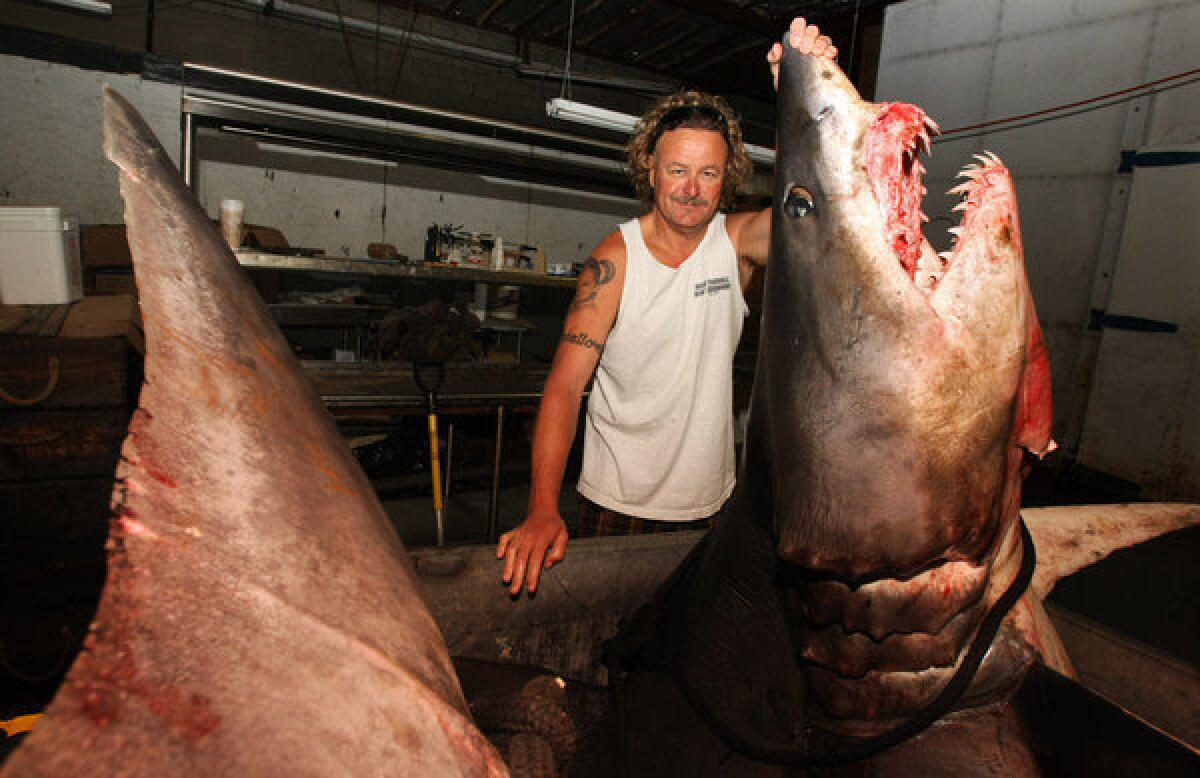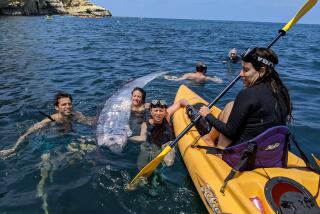Fisherman: Catching 1,300-pound mako shark âscariest thingâ ever

The fishermen who caught what may be a record-setting mako off the coast of Huntington Beach described an intense struggle to hook the 1,323-pound shark.
Boat Capt. Matt Potter, 34, who owns a store in Huntington Beach called Mako Mattâs Marine, said he and his buddies usually go sport shark fishing 20 days a year.
On Monday, they were on the third day of a three-day fishing trip when they spotted the fins, after scattering their âsecret sauceâ -- chopped mackerel and ground chum -- into the water.
PHOTOS: Sharks and people -- too close for comfort
The fins were a âdead giveaway,â said Richard Sanchez, a videographer from Dallas. âThere were so many screams...it was something really intense. YEE-HAW!â
Thus began some 2-1/2 hours of âstruggling, slipping and slidingâ as they tried to bring in the mammoth shark with giant hooks.
Jason Johnston, who lives in Mesquite, Texas, described it as âmayhem.â
The men had to keep the back of the boat squared with the shark to keep it in sight. Johnston wore a harness hooked to the shark and the boat to keep from being pulled overboard.
âI still feel the soreness in every bone,â Johnston said. âItâs the scariest thing Iâve ever done in my life.â
Franky Milinazzo, another fisherman, had the job of tying the shark to the side of the boat with a steel cable.
Had he faltered, Potter said, âWe could have lost it.â
Potter said the mako is the largest shark that can be legally caught.
The sharkâs body was taken to New Fishall, a Gardena processing plant, where it was weighed on a certified scale and put in the freezer. Potter said it will be used for research.
Nick Wegner, a fisheries research biologist at the Scripps Institution of Oceanography, said although he had heard of 1,400- to 1,500-pound mako sharks that were harpooned, the 1,300-plus-pound shark caught off the coast of Huntington Beach would set a new angling record.
âEncountering one this big is rare,â he said.
Makos are common off the coast of Southern California, which is considered a ânursery groundâ for the young sharks, he said. They tend to stay in open-ocean area â they donât come to the surf zone and âvery rarely have any interactions with people,â Wegner said, though fishermen commonly catch smaller makos between 2.5 and 6 feet long.
Makos typically feed off small fish like mackerel and sardines, and move on to larger fish as they get older, he said.
Theyâre also some of the fastest sharks in the ocean, Wegner said, which makes the catch all the more interesting. Unlike most fish, makos can warm up their core body temperatures, making their muscles move faster.
âTheyâre a fascinating animal,â he said.
Wegner said some of his colleagues had reached out to the fisherman that caught the shark, hoping to collect samples to learn more about the fish. The shark was likely a female based on its size, he said â male makos typically max out at 500 to 600 pounds.
Researchers are particularly interested in the sharkâs DNA and stomach contents, he said. Though the sharks typically feed off fish, a small seal pup was once found in a captured makoâs stomach, indicating they might have other food sources.
âItâs pretty rare to catch a fish this big,â he said. âIf we can see whatâs in the stomach, that gives us an idea of what theyâre eating.â
ALSO:
Woman killed in motorcycle accident got engaged that day
Luxury apartments evacuated as minivan plows into building
Man in custody following report of gunman at North Hills VA clinic
Twitter: @katemather
More to Read
Sign up for Essential California
The most important California stories and recommendations in your inbox every morning.
You may occasionally receive promotional content from the Los Angeles Times.












